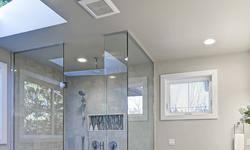
Ventilation FAQ
Frequently Asked questions
See below for our most frequently asked questions. Click on the questions to reveal the answers.
-
A sone is a measure of sound, the lower the sone the more comfortable the listening environment. In a typical installation a Panasonic Vent Fan operates at less than 0.3 sones. To put that in perspective, the average refrigerator runs at 1 sone. Sone readings mean we can easily compare sound levels of different products or situations. For a look at how some common sounds compare in sones, see the chart below.
-
Cubic feet per minute – a measure of volume flow rate, or air moving capability of an air moving device.
-
A measure of the resistance a fan must overcome before it can move or exhaust air. For more information, visit the Home Ventilation Institute website at www.hvi.org.
-
Replacement air for the air exhausted out of the structure by mechanical ventilation.
-
To calculate how many CFM of airflow is required to properly ventilate any room in your home, use the following calculation.
For an 8 foot ceiling take the square footage of the room and multiply it by 1.1. (Example – 10' x 10' room with 8' ceilings: 10' x 10' = 100 square feet x 1.1 = 110 CFM’s)
For any ceiling over 8 feet, take the height of the ceiling and multiply by .1375. Take this figure and multiply by the square footage of the room. This will equal the recommended CFMs. (Example – 10' x 12' room with 9' ceilings: 9' x .1375 = 1.24 x 120 square feet = 149 CFMs.)
Both calculations will give you the minimum recommended CFM.
-
Avoid using a 3" duct as this creates very high static pressure, reduces airflow dramatically, and over the long term, reduces motor life in the fan. If you are remodelling a house with existing 3" duct runs, one trick is to use the 3" as a guide for the 4" replacement duct. Simply slip the new 4" duct over the 3" and push it to the fan or to the wall to avoid having to expose the entire duct. Once the new duct is in place, pull out the 3" and dispose of it.
-
Yes, however a 3" to 4" adaptor is required.
-
Fan noise is created as air passes through the grille and enters the blower wheel assembly or fan blade as much of the noise is a function of the blower wheel.
Panasonic fans use a large diameter, wide blower wheel that moves a large amount of air at reduced RPMs. The blower wheel is approximately 60% larger than the competition's, but turns at a lower RPM, reducing tip speed and therefore noise.
The double suction blower wheel is designed to draw in air from both sides of the wheel as this helps keep the noise down and there is more area for the air to enter the wheel.
The exhaust outlet is as wide as the blower wheel, allowing less turbulent airflow as it enters the duct. It is then gradually stepped down before it enters the duct.
Panasonic fans use a four-pole condenser motor which helps the fan to rotate smoothly and evenly, reducing noise.
-
In terms of input wattage, Panasonic fans are among the lowest in the industry. This low wattage draw is accomplished in a number of ways, including:
Unique motor design
The fan condenser acts like a capacitor to store electrical energy and deliver it quickly and in exact amounts to the coil. This reduces the power draw, thus improving the electrical efficiency of the motor.Selective application
Panasonic builds its own fan motors and components, thereby optimizing efficiency by matching the exact motor characteristics with the desired performance of the fans.Wide blower wheel
The wide blower wheel improves airflow efficiency, enabling the fan to operate at lower RPM and reduce energy usage. -
Panasonic fans are designed to provide continuous operation for a minimum of 30,000 hours. They are actually designed to provide up to 100,000 hours of operation, but most fans have not been around long enough to reach that goal in testing. Some fans, however, have reached 60,000 hours in testing with virtually no wear on their components.
The following features enable the longevity of Panasonic fans:
Motor production
Panasonic motor production is fully automated, with an automatic defect detecting system and have a defect rate of less than 0.0006%.ISO 9001 plant
The production facilities that build Panasonic fans have been recognized by the International Standards Organization (ISO) as being among the highest quality factories in the world.Motor design
The electrical design of the fan motor allows it to operate at lower temperatures than most other motors, increasing the life of the motor and its bearings.Fan housing
The fan housing is made of heavy gauge zinc galvanized steel, and painted to protect it from rust. -
Yes. Loose fill or batt insulation can be placed directly over the fan housing in the attic. The efficient, cool-running motors and fluorescent bulbs in Panasonic's fans do not create enough ambient heat to prevent using insulation.
-
Yes, provided it is protected by a Ground Fault Circuit Interrupter (GFCI). Keep in mind, however, that any ventilation device located in a damp environment may have a reduced life due to high humidity and the potential for corrosion. Fans used in high-humidity areas should be operated for longer periods of time to ensure the removal of moisture and to reduce the potential for condensation in the fan body or ducting.
-
The Panasonic In-Line fan is a versatile system that you can use to provide multiple ventilation inlets in a large bathroom (e.g. shower, toilet, and vanity). Use it as a continuous (low rate) ventilation system with multiple inlets throughout the home to improve indoor air quality. Or, use it to ventilate two bathrooms at once.
-
No. Fans installed above kitchen ranges must be listed for that application by UL, and must be designed to handle grease and high temperatures. Panasonic fans should only be used to provide auxiliary kitchen ventilation. An alternate approach is to use a ducted range hood or downdraft exhaust, and a Panasonic ventilation fan to exhaust the general odours and moisture in the kitchen.
-
You should never exhaust into the attic space. Moisture could damage the building materials.
-
If this is happening, it might be caused by a faulty roof jack allowing rain to come into the duct, or condensation from warm, humid air in the house striking the cold duct surface.
If your fan has a problem with condensation, two things may help. First, try operating the fan for longer periods of time to carry out more of the moisture, so the air is not humid when the fan stops running. Moisture will generally not form when the fan is running unless it is very cold, or the installation has a very long duct run in a cold attic. Second, you can insulate the duct to reduce the probability of condensation.
Also, if the fan does not appear to be clearing moisture from the room, check the ducting and run time of the fan. Poor duct design, installation, or damage may prevent the fan from overcoming the static pressure of the duct, which means that it will not be able to get the air and therefore the moisture out.
Be sure to contact your local electrical and building officials to ensure local building and electrical codes are met before attempting to install ventilation fans in your home.
Sone Chart
| Sound level situation | Sone level | How we feel |
|---|---|---|
| Traffic noise | 7.0 - 8.0 | Conversation with added noise |
| TV/Radio | 3.0 - 7.0 | Normal conversation |
| Calm office | 1.5 - 3.0 | Normal Conversation |
| Night in Suburbs | 1.0 | Comfortable zone free from noise |
| Rustling shrubs | 0.5 |

